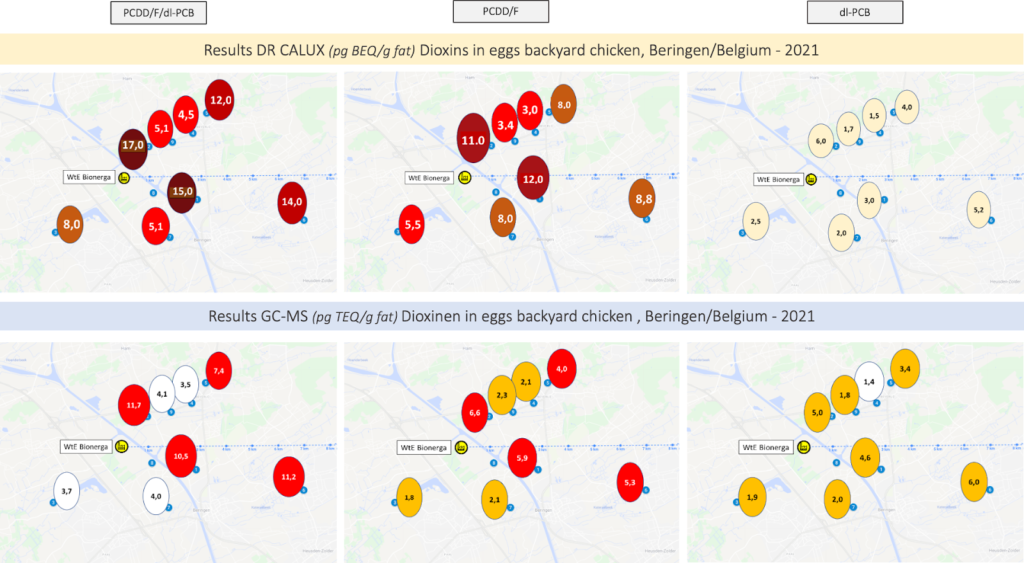
More worrying results from biomonitoring of waste incineration emissions – ToxicoWatch research on the Beringen incinerator
2022 is bringing us plenty of updates and developments on the harmful effects of waste incineration on both the environment and the health of living organisms (including human health). After starting the year with the publication of Zero Waste Europe’s “The True Toxic Toll: biomonitoring of waste incineration” reports detailing findings in Lithuania, Czechia, and Spain, and after Colletif3R’s report on the nefarious effects of the Ivry-Paris XIII incinerator in France, we now receive further proof in this direction from Belgium. The following text is courtesy of our research partner ToxicoWatch.
In 2019, the town council of Beringen (Belgium) has commissioned ToxicoWatch (TW) to carry out non-human biomonitoring research on dioxins (PCDD/F) and dioxin-like PCB (dl-PCB) concerning emissions possible related to the town’s waste-to-energy (WtE) incineration plant Bionerga. This waste incinerator started its operations in 2020. TW’s 2021 report on this subject represented the second measurement of a three-year biomonitoring study on dioxin emissions in Bionerga’s immediate surroundings. It is worth noting that the first measurement instance took place in October 2019, before WtE plant Bionerga started its production – thus representing a so-called “zero measurement”. The third one will take place in the autumn of 2022.
As biomarkers of Substances of Very High Concern (SVHC) (like dioxins), TW analysed chicken eggs from eight private chicken coop owners for the presence of dioxins (PCDD/F) and dioxin-like PCB (dl-PCB). The 2021 results of the analytical bioassay method DR CALUX show contamination of dioxins at all eight chicken egg locations with values (far) above the action level of 3.3 pg BEQ/g fat for the sum of dioxins (PCDD/F/dl-PCB). What’s more, these very high DR CALUX values mean that we needed to do further verifications using chemical GC-MS analysis, as per the EU 709/2014 regulations.

All in all, the key findings of the TW Biomonitoring study Beringen/Belgium – 2021 show that:
- 50% of chicken eggs analysed do not meet EU dioxin standard regulations for consumption (if these eggs were produced for the commercial market).
- The closer a location is to the incinerator, the higher the level of dioxins registered.
- Monitoring instances done using “Bergerhoff gauges” – a monitoring instrument to measure for dust deposition on-site – show increasing high levels of dioxins during the start-up and elevated levels in operational phases of the Bionerga waste incinerator.
- Heptachlorodibenzofuran (HpCDF1) and Octachlorodibenzo-p-dioxin (OCDD), typical incomplete combustion-related congeners, are key congeners in the emissions patterns of Bionerga waste incinerator – which was also found in the chemical GC-MS analysis in the eggs.
- In four egg locations, significantly elevated Heptachlorodibenzofuran (HpCDF1) was registered.
- In three egg locations, Octachlorodibenzo-p-dioxin (OCDD) was found to have increased by more than 100%.
- On a given reference egg location, dl-PCB was found to have increased by a factor of 14, – thus warranting more research in the future.
- The congener patterns of the short-term measurements of the emissions from the Bionerga waste incinerator show similarities with the analysis results in the chicken eggs stemming from this research.
All in all, the increase of dioxins in chicken eggs warrants more research, as it concerns very dangerous substances which can have serious consequences for the health of humans, animals, and living organisms in the environment.

Read ToxicoWatch’s full biomonitoring report on the Bionerga waste incinerator (available in both NL and EN) HERE.